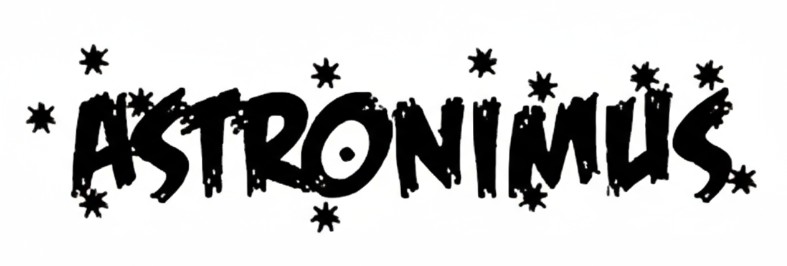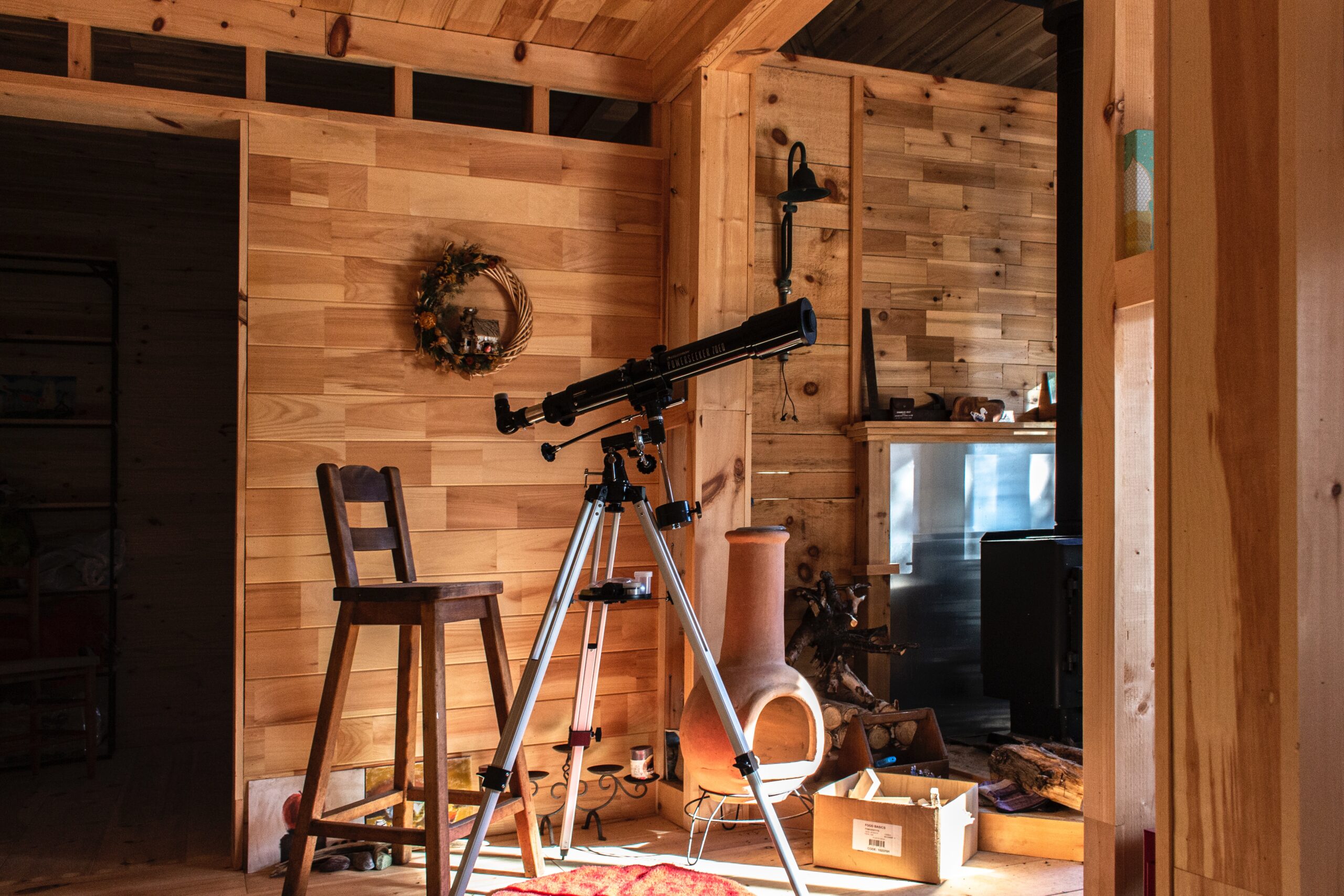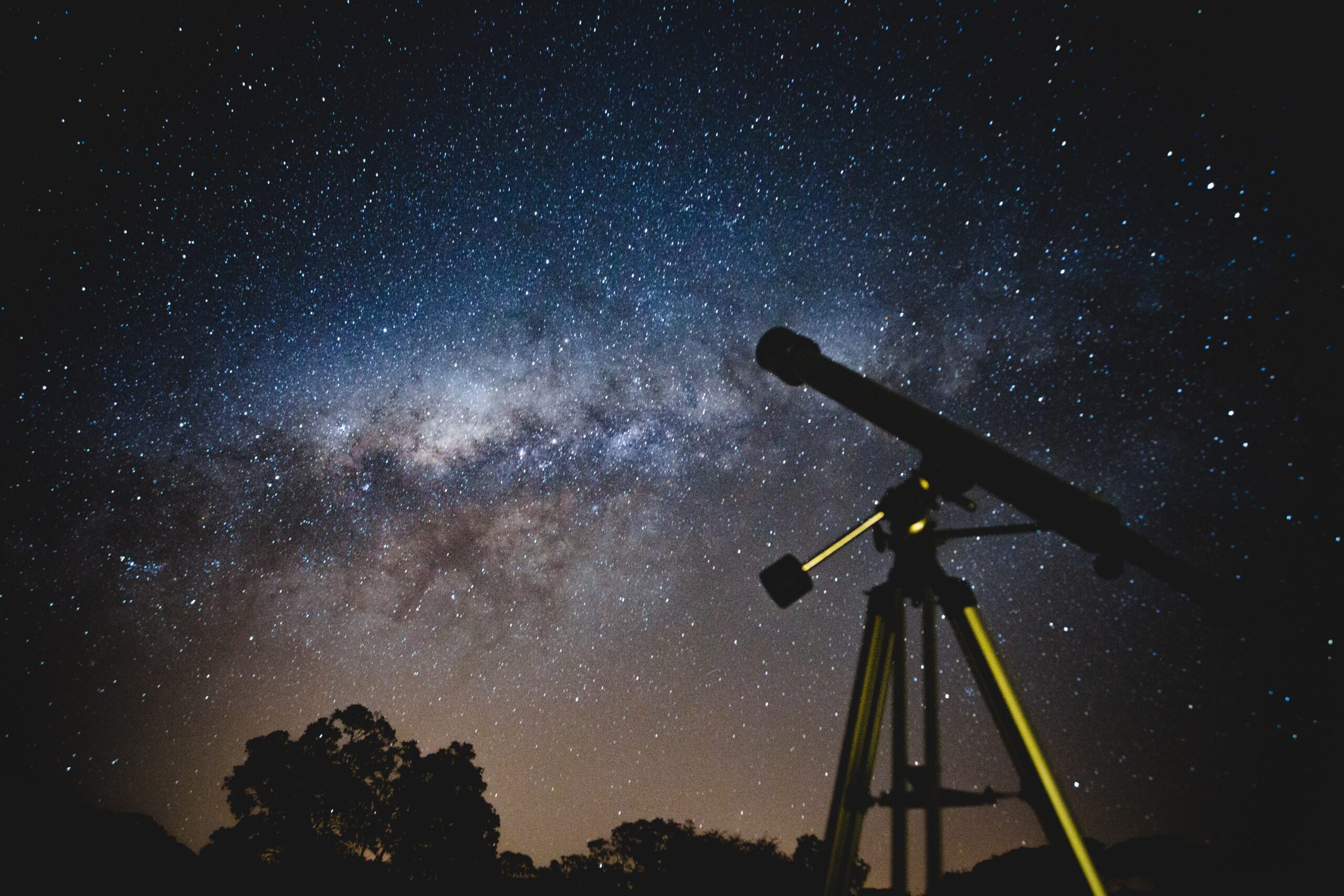Understanding Different Telescope Mount Types: Alt-Azimuth Vs. Equatorial
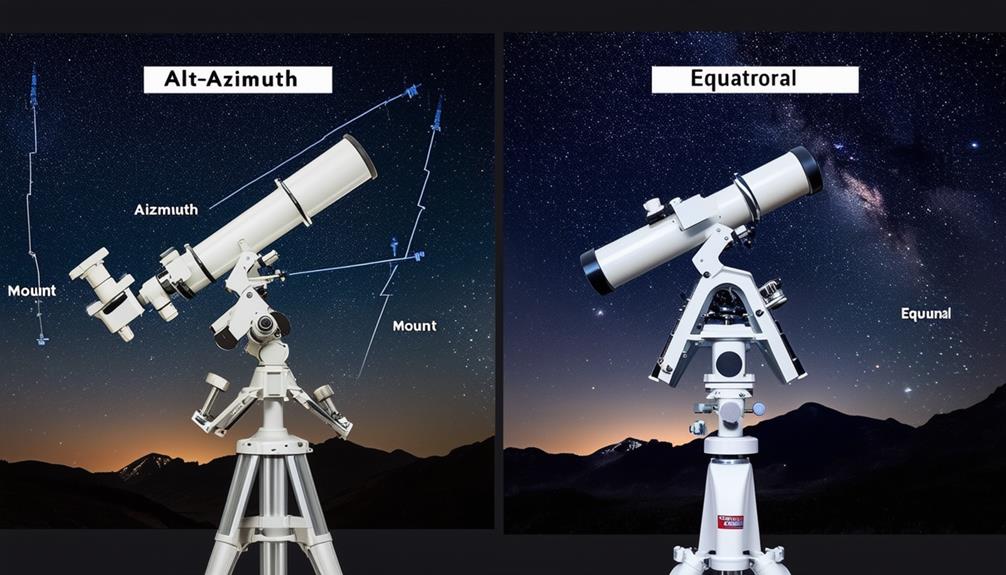
When selecting a telescope mount, it's crucial to understand the key distinctions between alt-azimuth and equatorial mounts. Alt-azimuth mounts are straightforward and versatile, making them ideal for beginners who prioritize ease of use.
On the other hand, equatorial mounts align with Earth's rotation, providing the precise tracking necessary for astrophotography. Each mount type offers distinct advantages depending on your stargazing or imaging objectives. So, which mount best suits your needs? Let's delve into the details to guide you to the right decision.
Overview of Telescope Mounts
Telescope mounts are essential for stabilizing and maneuvering your telescope, with two primary types: altazimuth and equatorial. These mounts are crucial for observing and tracking celestial objects, making them indispensable for amateur astronomers.
Altazimuth mounts move in altitude (up and down) and azimuth (side to side) directions. They're easy to set up and intuitive to use, especially for beginners. With an altazimuth mount, you can quickly point your telescope at different celestial objects without worrying about complex adjustments. Though simpler, they're excellent for casual stargazing and terrestrial viewing.
Equatorial mounts, in contrast, are specifically designed for tracking celestial objects across the sky. Aligned with the Earth's axis, these mounts enable precise tracking of stars and planets as the Earth rotates. This feature is particularly beneficial for astrophotography, where long exposure times require accurate tracking. German equatorial mounts, a popular subtype, use a counterweight system to maintain balance during observations.
Alt-Azimuth Mount Characteristics
When starting out in astronomy, an alt-azimuth mount offers a user-friendly experience with its straightforward up/down and left/right movements. Alt-azimuth mounts are perfect for beginners because they're easy to set up and operate. These mounts allow you to quickly adjust your telescope to observe both terrestrial and celestial objects, making your stargazing sessions enjoyable and hassle-free.
Here are three reasons why alt-azimuth mounts are popular among novice astronomers:
- Ease of Use: Alt-azimuth mounts require minimal setup and are intuitive to operate, allowing you to focus more on observing rather than adjusting complex equipment.
- Versatility: Ideal for scanning the sky and planetary imaging, these mounts are great for short-exposure astrophotography and live viewing of celestial objects.
- Affordability: Typically more affordable than equatorial mounts, alt-azimuth mounts provide excellent value for beginners exploring astronomy without a significant investment.
While alt-azimuth mounts excel in live viewing and short exposure stacking, they aren't suitable for deep sky astrophotography due to field rotation issues.
However, for scanning the sky and enjoying the beauty of planets and stars, an alt-azimuth mount is an excellent choice. Whether you're observing terrestrial landscapes or celestial wonders, this mount type offers a fantastic balance of simplicity and functionality.
Equatorial Mount Characteristics
To use an equatorial mount effectively, precise polar alignment is crucial for accurate tracking of celestial objects. This step is particularly important in astrophotography, as it enables the mount to follow the stars' motion accurately, allowing for long-exposure images without star trails.
Precise Polar Alignment
Aligning the polar axis with the celestial pole is crucial for an equatorial mount to track stars accurately. This precise polar alignment ensures that your telescope moves in sync with the stars' motion across the night sky, compensating for Earth's rotation.
Importance of Precise Polar Alignment
Proper alignment allows equatorial mounts to follow celestial objects smoothly, minimizing tracking errors. Precise polar alignment is essential for obtaining sharp and detailed astronomical views. Once aligned, making fine adjustments and locating objects becomes simpler and more intuitive.
Steps to Achieve Precise Polar Alignment
- Initial Setup: Point your mount's polar axis towards the celestial pole, typically Polaris in the Northern Hemisphere.
- Use Tools for Accuracy: Utilize a polar scope or alignment software to facilitate the alignment process.
- Fine-Tuning: Adjust the declination axis and right ascension axis for maximum accuracy.
Key Considerations
Even slight misalignments can lead to significant tracking errors. Take your time with this step to ensure optimal alignment.
Ideal for Astrophotography
For capturing the best astrophotography images, equatorial mounts stand unparalleled due to their precise tracking capabilities. These mounts are essential for long-exposure imaging, enabling detailed views of galaxies, nebulae, and star clusters. Their effectiveness lies in their precise polar alignment, which minimizes field rotation and ensures clear, sharp images.
Equatorial mounts with motorized drives are transformative for astrophotography. These automated systems allow you to track celestial objects accurately, maintaining alignment over extended periods. This precise tracking is crucial for capturing stunning long-exposure images without star trails.
Here's a quick comparison to visualize the advantages of equatorial mounts in astrophotography:
| Feature | Equatorial Mounts | Alt-Azimuth Mounts |
|---|---|---|
| Tracking Accuracy | High | Variable |
| Long-Exposure Imaging | Ideal | Challenging |
| Polar Alignment | Required | Not Required |
| Motorized Drives | Common | Less Common |
With an equatorial mount, aligning and tracking stars becomes significantly easier, making it the preferred choice for serious astrophotographers. By leveraging these mounts, you can enhance your astrophotography and capture the night sky like never before.
Comparing Alt-Azimuth and Equatorial
When comparing alt-azimuth and equatorial mounts, consider their tracking mechanisms, setup complexity, and imaging capabilities. Alt-azimuth mounts are easier to set up and use, making them ideal for beginners and casual observers. Equatorial mounts, on the other hand, provide superior tracking and imaging capabilities, which are crucial for long-exposure astrophotography.
Tracking Mechanisms
Tracking celestial objects involves different techniques depending on whether you're using an Alt-Azimuth (Alt-Az) or Equatorial mount.
With an Alt-Az setup, you'll rely on iterative movements, meaning the mount adjusts in small up/down and left/right steps. This makes it ideal for visual astronomy and planetary imaging, where precise extended exposure astrophotography isn't a priority.
Equatorial mounts, on the other hand, are designed for more accurate tracking. They tilt based on your latitude, aligning with Earth's rotation. This setup allows you to follow celestial objects smoothly and precisely, making it perfect for extended exposure astrophotography.
Key points to consider:
- Alt-Az Tracking:
- Uses iterative movements.
- Best for live viewing and short exposure stacking.
- Simpler and more user-friendly for beginners.
- Equatorial Tracking:
- Aligns with Earth's rotation for smoother tracking.
- Essential for extended exposure astrophotography.
- Requires precise polar alignment for optimal performance.
Choosing between these mounts depends on your specific needs. If you're just starting or focusing on planetary imaging, an Alt-Az mount might suit you best. However, for serious astrophotography, an equatorial mount provides the precision needed for stunning extended exposure shots.
Setup Complexity
When considering tracking mechanisms, the setup complexity of Alt-Azimuth and Equatorial mounts significantly impacts which is best suited for your needs. Alt-Azimuth mounts are generally ideal for those seeking simplicity. They don't require polar alignment, making them much easier for beginners to set up. You can simply point and observe, which is perfect for casual observing sessions.
Equatorial mounts, however, require more effort. Accurate tracking necessitates precise polar alignment, which involves aligning the mount with the celestial pole and can be time-consuming. Additionally, you'll need to balance the telescope and possibly configure intricate tracking systems, especially if you aim to follow objects for extended periods.
Imaging Capabilities
For astrophotography enthusiasts, selecting the right mount can significantly impact the quality and ease of capturing celestial images. Here are some key factors to consider:
- Field Rotation: Alt-Azimuth mounts experience field rotation during long exposures, making them less ideal for detailed astrophotography. This occurs because the mount's movement doesn't align perfectly with Earth's rotation, causing stars to appear to rotate around the image center over time.
- Tracking Accuracy: Equatorial mounts offer superior tracking accuracy by aligning one axis with Earth's rotational axis. This precise alignment allows for longer exposures without star trailing, essential for capturing clear images of deep-sky objects.
- Imaging Efficiency: Equatorial mounts are more efficient for astrophotography, often equipped with motor drives to compensate for Earth's rotation. This enables the capture of sharp, detailed celestial images with minimal manual adjustments.
While techniques exist to mitigate the limitations of Alt-Azimuth mounts, Equatorial mounts provide a more straightforward and reliable solution for high-quality astrophotography. Investing in an Equatorial mount is highly recommended for those serious about capturing the beauty of the night sky.
Advantages of Alt-Azimuth Mounts
Alt-Azimuth mounts offer a straightforward setup, eliminating the need for polar alignment, making them ideal for beginners. Their quick setup process requires no counterweights, enhancing user-friendliness. Whether you're into planetary imaging or prefer simple live viewing sessions, these mounts provide versatility and ease of use.
| Feature | Alt-Azimuth Mounts | Emotion Evoked |
|---|---|---|
| Setup | Quick and easy | Relief and Excitement |
| Alignment | No polar alignment needed | Simplicity and Joy |
| Counterweights | Not required | Convenience |
| User Level | Ideal for beginners | Confidence and Comfort |
| Imaging Type | Planetary imaging, live viewing | Satisfaction and Wonder |
These mounts excel in short exposure stacking, enabling you to capture detailed planetary images without the complexity of an equatorial mount. Their user-friendly design makes them a popular choice for novice telescope users, making the wonders of the night sky easily accessible.
With Alt-Azimuth mounts, your focus remains on enjoying observations rather than on technical adjustments. Their design prioritizes ease of use, democratizing astronomy for all skill levels. If you seek a mount that offers both practicality and simplicity, an Alt-Azimuth mount is your optimal choice.
Advantages of Equatorial Mounts
For long-exposure astrophotography, equatorial mounts offer unmatched tracking precision. These mounts are designed to follow celestial objects as the Earth rotates, ensuring your images are sharp and detailed during extended exposures.
One of the main advantages of equatorial mounts is their ability to achieve precise polar alignment. By aligning your telescope with the Earth's axis, you can track celestial objects accurately, which is crucial for both astrophotography and visual astronomy.
Here are three key benefits of equatorial mounts:
- Exceptional Tracking: With precise polar alignment, equatorial mounts follow stars and planets smoothly, making them ideal for capturing faint celestial objects during long exposure times.
- Comfortable Viewing: For visual astronomy, the ergonomic design often places the eyepiece in a more accessible position, enhancing your overall experience.
- Versatility: Equatorial mounts are suitable for both astrophotographers and experienced visual astronomers, making them a versatile choice for diverse observing and imaging needs.
Astrophotography Considerations
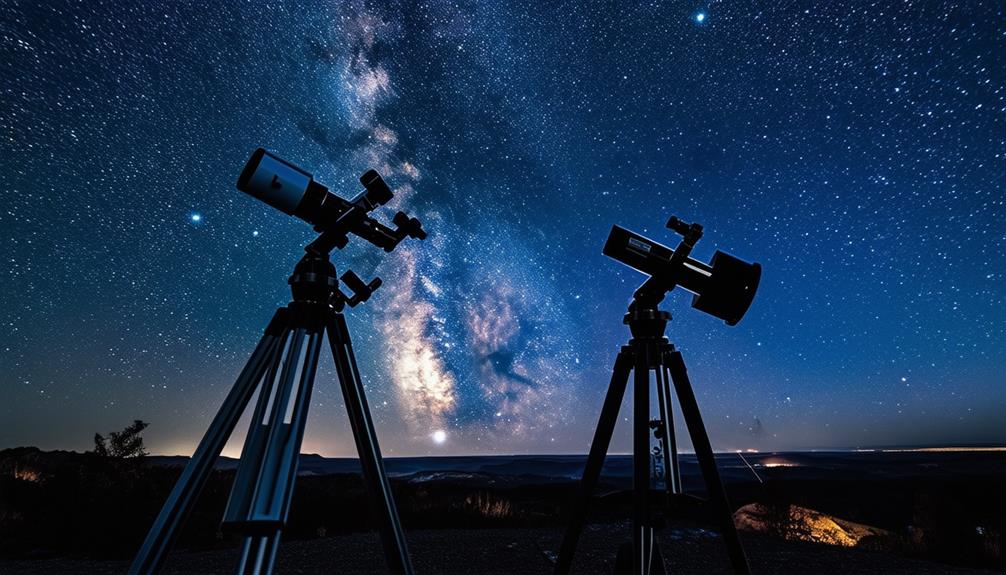
When delving into astrophotography, selecting the right mount is crucial for capturing detailed images of the night sky. Equatorial mounts are generally preferred because they excel in tracking celestial objects accurately over extended periods, which is vital for long-exposure shots. Even slight deviations can blur the image, but the design of Equatorial mounts allows for smoother tracking, making them ideal for capturing intricate details of distant stars and galaxies.
Alt-Azimuth mounts, on the other hand, can be used for astrophotography but come with limitations. They're often less stable and not as efficient for long-exposure photography. While they can track celestial objects, they might require extra accessories or techniques to improve their stability and tracking accuracy, such as wedge adapters or software adjustments. This adds complexity to your setup.
Equatorial mounts typically come with motor drives that compensate for Earth's rotation, ensuring that your telescope stays aligned with the object you're photographing. This feature is indispensable for capturing clear, crisp images without constant manual adjustments. Hence, for those serious about astrophotography, investing in an Equatorial mount is often the best choice.
Choosing the Right Mount
Selecting the right mount involves balancing your observing preferences, future needs, and practical considerations like portability and setup time. Here's how to make an informed choice:
Observing Preferences:
If you prioritize ease of use, an alt-azimuth (alt-az) mount may be ideal. It's excellent for casual stargazing and quick setup. However, if long-exposure astrophotography is your goal, an equatorial mount provides superior tracking capabilities.
Portability and Setup Time:
Consider where and how often you'll observe. Alt-az mounts are generally more portable and quicker to set up. While equatorial mounts are more complex, they offer precision in tracking celestial objects, making them worth the extra effort for serious astronomers.
Adaptability and Future Needs:
Think ahead. If you plan to explore astrophotography in the future, an equatorial mount offers greater adaptability. Look for features like GOTO technology, which simplifies finding and tracking objects.
Conclusion
Choosing the right telescope mount depends on your stargazing and astrophotography goals. If you're a beginner or enjoy casual observing, you'll appreciate the simplicity and ease of an alt-azimuth mount. However, if precision tracking for long-exposure astrophotography is your priority, an equatorial mount is your best option. Consider what you value most in your celestial adventures to make the perfect choice. Happy stargazing!
